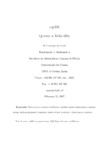Queues in Reliability

Ver/
Use este enlace para citar
http://hdl.handle.net/2183/864Coleccións
- GI-MODES - Artigos [142]
Metadatos
Mostrar o rexistro completo do ítemTítulo
Queues in ReliabilityAutor(es)
Data
2007Cita bibliográfica
Aparecerá en Encyclopedia of Statistics in Quality and Reliability
Resumo
Queueing models can be useful in solving many complex reliability problems. Component
failures are usually interpreted as the arrival of customers and the repair or
replacement of failed components is typically associated with the service facility. A
distinctive characteristic of queues in reliability is that requests for service are usually
generated by a finite customer population because, in general, there are a limited number
of units, e.g. machines which can fail, and when they are all in the system, being
repaired or waiting for repair, no more can arrive. Thus the arrivals do not form a
renewal process as they may depend on the number of units in the system. This is an
essential difference from typical queueing systems, where the population of potential
arrivals can be considered to be effectively limitless. This article overviews the main
queueing models used in reliability which are illustrated using the classical machine
repairmen model. Some statistical methods to estimate the main quantities of interest
in a queue are also discussed.
Palabras chave
Finite source
Machine interference
Machine repair
Maintenance
Manufacturing
Multi-programmed computers
Multi-echelon inventory
Retrial
Spares
Vacation
Machine interference
Machine repair
Maintenance
Manufacturing
Multi-programmed computers
Multi-echelon inventory
Retrial
Spares
Vacation





